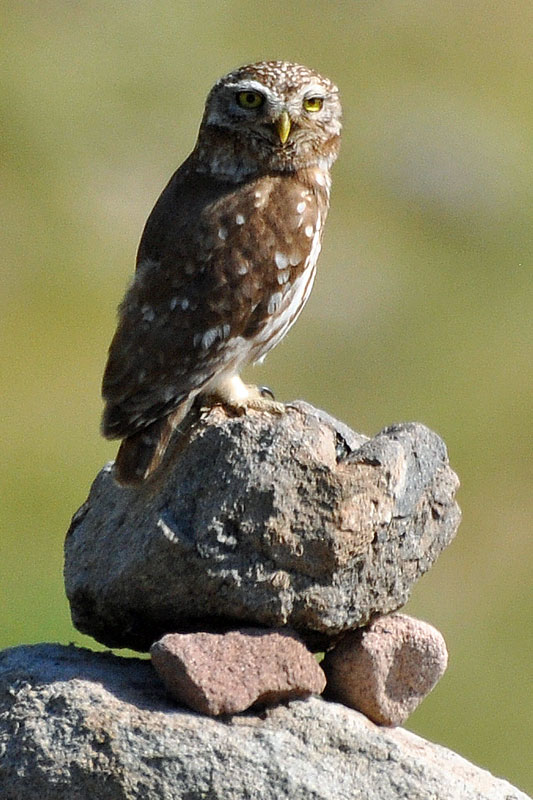By Megan Lock, GWCT Advisor
Happy New Year!
January was named after the god Janus (Latin word for ‘door’) who has two faces, which allowed him to look both backwards into the old year and forwards into the new one at the same time, so with that in mind, I thought I would choose a species that had the ability to turn its head just like the god Janus – an owl, and in particular one of my favourite owls, the little owl (Athene noctua).

Although it is widely thought that the little owl is a native species, it is not, having been introduced to Britain from the continent in the 1800s. From then they quickly spread, and by the 1920s they could be found in Scotland and Wales. But unlike many other alien species, they appear to have occupied a vacant niche without having any detrimental impact on other native species.
So, what do they look like? The little owl lives up to its name, standing at only 20cm in height, and is our smallest owl in the UK. They have piercing yellow eyes, are mottled brown and cream across the head and body, and they have a short tail and small, rounded wings. But what they lack in size, they make up for in attitude by the way they stare at you with such annoyance if you dare to be in their territory and alarm call (shout at you!) so loudly!
The little owl is a species of open country, favouring habitats such as mixed farmland, parkland and orchards and are crepuscular (Latin for ‘twilight’), meaning they are most active at dawn and dusk. However, they are quite often seen during the day basking in the sunshine on a telegraph pole or tree. They are a sedentary species and hunt mainly at night from a perch rather than on the wing, taking crickets, grasshoppers and other invertebrates as well as small mammals, earthworms and, on some occasions, small birds during the breeding season.
When prey is spotted, they sometimes bob up and down a few times before a short flight to capture their prey, and if their aim wasn’t successful, they sometimes pursue their prey on the ground on foot!
The little owl’s territory size varies throughout the year, ranging from 40ha prior to the breeding season to as little as 2ha as the pair provision young. They establish their territory in the late winter and early spring, when males can be particularly noisy. Little owls are very territorial during the breeding season, and consequently very vocal again, with a wide variety of vocalisations. Typical calls include a plaintive ‘kew’ ‘kew’ and a loud ‘wherrow’, repeated at regular intervals. One of my favourite memories of this species was when I worked on a small farm as a teenager – we would turn the cattle out in the evening, and as we walked the cattle up the track to the fields, the calls of the little owls would fill the air, and that has stuck with me ever since.
Little owls are a cavity-nesting species, with nests recorded in rock crags, rabbit holes and haystacks as well as in old agricultural buildings and tree holes, typically located within hedgerow trees. They prefer to nest in small dark cavities, with the male often perching close to the nest cavity while his mate is incubating her clutch of eggs.
Little owls are monogamous and are faithful to their nest sites and will return year after year, provided both of the pair survive. They lay between 3-5 eggs towards the end of April, with incubation lasting about a month, and the young fledge at around 5-6 weeks of age but are dependent on the adults for a further 2-4 weeks thereafter.
Following their successful introduction in the late 1800s, the species has experienced a decline in both range and population. They are absent from Ireland, and have disappeared from almost all of Scotland. Between 1995 and 2010 little owls declined by an estimated 40%, particularly in the western part of their range. They are now considered scarce in Wales and the western counties of Cheshire, Devon and Cornwall. The reasons for decline are unknown, but the most significant influences on nesting success is the availability of food and prevailing weather conditions, particularly cold, wet weather. We cannot tackle the climate crisis alone, but what we can do is create and manage prey-rich habitat for the little owl or erect owl nest boxes.
So, keep your eye out for these small but larger than life owls. They are sometimes hard to spot, but when you’ve heard one, you won’t forget it!
